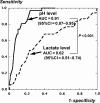Prognostic values of blood pH and lactate levels in patients resuscitated from out-of-hospital cardiac arrest
- PMID: 28163922
- PMCID: PMC5256427
- DOI: 10.1002/ams2.217
Prognostic values of blood pH and lactate levels in patients resuscitated from out-of-hospital cardiac arrest
Abstract
Aim: Early prediction of prognosis after out-of-hospital cardiac arrest (OHCA) remains difficult. High blood lactate or low pH levels may be associated with poor prognosis in OHCA patients, but these associations remain controversial. We compared blood lactate and pH levels in OHCA patients transferred to our hospital to measure their prognostic performance.
Methods: We investigated the associations between blood lactate and pH levels on admission and neurological outcomes in 372 OHCA patients who had a return of spontaneous circulation.
Results: Of the 372 OHCA patients, 31 had a favorable neurological outcome. Blood lactate levels were lower in patients with a favorable outcome than in those with an unfavorable outcome, but this difference did not reach statistical significance (82 ± 49 vs. 96 ± 41 mg/dL). However, pH levels were significantly higher in patients with a favorable outcome than in those with an unfavorable outcome (7.26 ± 0.16 vs. 6.93 ± 0.19, P < 0.001). The relative cumulative frequency distribution curve analysis showed the optimal cut-off points of lactate and pH to be approximately 80 mg/dL and 7.05, respectively. Sensitivity and specificity to predict a favorable outcome were 61% and 64% for lactate <80 mg/dL and 84% and 80% for pH >7.05, respectively. Areas under receiver-operating characteristic curves were significantly larger for pH than for lactate levels (P < 0.001). In multivariate analysis, pH >7.05 was an independent predictor for a favorable outcome.
Conclusion: After OHCA, patients with a favorable outcome had lower lactate and higher pH levels than those with an unfavorable outcome, but pH level was a much better predictor for neurological outcome than lactate levels.
Keywords: Blood pH; lactate; out‐of‐hospital cardiac arrest; predictors; prognosis.
Figures


Similar articles
-
Lactate-to-albumin ratio and cholesterol levels predict neurological outcome in cardiac arrest survivors.Am J Emerg Med. 2024 Sep;83:9-15. doi: 10.1016/j.ajem.2024.06.029. Epub 2024 Jun 25. Am J Emerg Med. 2024. PMID: 38943710
-
Initial Blood pH, Lactate and Base Deficit Add No Value to Peri-Arrest Factors in Prognostication of Neurological Outcome After Out-of-Hospital Cardiac Arrest.Front Med (Lausanne). 2021 Sep 16;8:697906. doi: 10.3389/fmed.2021.697906. eCollection 2021. Front Med (Lausanne). 2021. PMID: 34604252 Free PMC article.
-
Lactate and pH as Independent Biomarkers for Prognosticating Meaningful Post-out-of-Hospital Cardiac Arrest Outcomes: A Systematic Review and Meta-Analysis.J Clin Med. 2025 Mar 25;14(7):2244. doi: 10.3390/jcm14072244. J Clin Med. 2025. PMID: 40217695 Free PMC article. Review.
-
Early blood transcriptomic signature predicts patients' outcome after out-of-hospital cardiac arrest.Resuscitation. 2019 May;138:222-232. doi: 10.1016/j.resuscitation.2019.03.006. Epub 2019 Mar 15. Resuscitation. 2019. PMID: 30885824 Clinical Trial.
-
Prognostic utility of neuroinjury biomarkers in post out-of-hospital cardiac arrest (OHCA) patient management.Med Hypotheses. 2017 Aug;105:34-47. doi: 10.1016/j.mehy.2017.06.016. Epub 2017 Jun 24. Med Hypotheses. 2017. PMID: 28735650 Review.
Cited by
-
Comparison of Prognostic Performance between Procalcitonin and Procalcitonin-to-Albumin Ratio in Post Cardiac Arrest Syndrome.J Clin Med. 2023 Jul 9;12(14):4568. doi: 10.3390/jcm12144568. J Clin Med. 2023. PMID: 37510683 Free PMC article.
-
[Recommendations for extracorporeal cardiopulmonary resuscitation (eCPR) : Consensus statement of DGIIN, DGK, DGTHG, DGfK, DGNI, DGAI, DIVI and GRC].Med Klin Intensivmed Notfmed. 2018 Sep;113(6):478-486. doi: 10.1007/s00063-018-0452-8. Med Klin Intensivmed Notfmed. 2018. PMID: 29967938 German.
-
Pre and postoperative lactate levels and lactate clearance in predicting in-hospital mortality after surgery for gastrointestinal perforation.BMC Surg. 2022 Mar 9;22(1):93. doi: 10.1186/s12893-022-01479-1. BMC Surg. 2022. PMID: 35264127 Free PMC article.
-
Survival with Good Neurological Outcome despite Prolonged Cardiopulmonary Resuscitation and Extreme Acidosis after Out-of-Hospital Cardiac Arrest Due to Acute Myocardial Infarction: A Case Report and Review of the Literature.Clin Pract. 2023 May 15;13(3):616-620. doi: 10.3390/clinpract13030056. Clin Pract. 2023. PMID: 37218807 Free PMC article.
-
The early change in pH values after out-of-hospital cardiac arrest is not associated with neurological outcome at hospital discharge.Resusc Plus. 2024 May 1;18:100650. doi: 10.1016/j.resplu.2024.100650. eCollection 2024 Jun. Resusc Plus. 2024. PMID: 38711912 Free PMC article.
References
-
- Adielsson A, Hollenberg J, Karlsson T et al Increase in survival and bystander CPR in out‐of‐hospital shockable arrhythmia: bystander CPR and female gender are predictors of improved outcome. Heart 2011; 97: 1391–6. - PubMed
-
- Blom MT, Beesems SG, Homma PCM et al Improved survival after out‐of‐hospital cardiac arrest and use of automated external defibrillators. Circulation 2014; 130: 1868–75. - PubMed
-
- Iwami T, Nichol G, Hiraide A et al Continuous improvements in “chain of survival” increased survival after out‐of‐hospital cardiac arrests. Circulation 2009; 119: 728–34. - PubMed
-
- Kitamura T, Iwami T, Kawamura T et al Nationwide improvements in survival from out‐of‐hospital cardiac arrest in Japan. Circulation 2012; 126: 2834–43. - PubMed
-
- Mullner M, Sterz F, Domanovits H, Behringer W, Binder M, Laggner AN. The association between blood lactate concentraton on admission, duration of cardiac arrest, and functional neurological recovery in patients with resuscitated from ventricular fibrillation. Intensive Care Med. 1997; 23: 1138–43. - PubMed
LinkOut - more resources
Full Text Sources
Other Literature Sources

